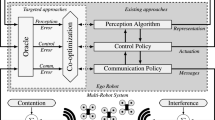Abstract
In this paper, the distributed and recursive blind channel identification algorithms are proposed for single-input multi-output (SIMO) systems of sensor networks (both time-invariant and time-varying networks). At any time, each agent updates its estimate using the local observation and the information derived from its neighboring agents. The algorithms are based on the truncated stochastic approximation and their convergence is proved. A simulation example is presented and the computation results are shown to be consistent with theoretical analysis.
Similar content being viewed by others
References
R. Liu. Blind signal processing: an introduction. Proceedings of the 2nd IEEE International Symposium on Circuits and Systems, Atlanta: IEEE, 1996: 81–84.
D. Slock. Blind fractionally spaced equalization perfect reconstruction filter banks and multichannel linear prediction. Proceedings of the 4th IEEE International Conference on Acoustics, Speech, and Signal Processing, Adelaide, Australia: IEEE, 1994: 585–588.
Y. Hua. Fast maximum likelihood for blind identification of multiple FIR channels. IEEE transactions on Signal Processing, 1996, 44(3): 661–672.
F. Alberg, P. Duhamel, M. Nikolova. Adaptive solution for blind identification/equalization using deterministic maximum likelihood. IEEE Transactions on Signal Processing, 2002, 50(4): 923–936.
E. Moulines, P. Duhamel, J. Cardoso, et al. Subspace methods for the blind identification of multichannel FIR filters. IEEE Transactions on Signal Processing, 1995, 43(2): 516–525.
G. Xu, H. Liu, L. Tong, et al. A least-squares approach to blind channel identification. IEEE Transactions on Signal Processing, 1995, 43(12): 2982–2993.
Q. Zhao, L. Tong. Adaptive blind channel estimation by least squares smoothing. IEEE Transactions on Signal Processing, 1999, 47(11): 3000–3012.
H. F. Chen, X. Cao, J. Zhu. Convergence of stochasticapproximation- based algorithms for blind channel identification. IEEE Transactions on Information Theory, 2002, 48(5): 1214–1225.
H. Fang, H. F. Chen. Blind channel identification based on noisy observation by stochastic approximation method. Journal of Global Optimization, 2003, 27(2): 249–271.
R. Abdolee, B. Champagne. Distributed blind adaptive algorithms based on constant modulus for wireless sensor networks. Proceedings of IEEE International Conference on Wireless and Mobile Communications, Valencia, Spain: IEEE, 2010: 303–308.
C. Yu, L. Xie, Y. Soh. Distributed blind system identification in sensor networks. Proceedings of IEEE International Conference on Acoustics, Speech and Signal Processing, Florence, Italy: IEEE, 2014: 5065–5069.
J. Lei, H. F. Chen. Distributed estimation for parameter in heterogeneous linear time-varying models with observations at network sensors. Communications in Information and Systems, 2015, 15(4): 423–451.
J. Brewer. Kronecker products and matrix calculus in system theory. IEEE Transactions on Circuits and Systems, 1978, 25(9): 772–781.
J. Lei, H. F. Chen. Distributed stochastic approximation algorithm with expanding truncations: algorithm and applications. arXiv, 2014: arXiv:1410.7180.
Author information
Authors and Affiliations
Corresponding author
Additional information
This paper is dedicated to Professor T. J. Tarn on the occasion of his 80th birthday.
This work was supported by the National Key Basic Research Program of China (973 program, No. 2014CB845301), and the National Center for Mathematics and Interdisciplinary Science, Chinese Academy of Sciences.
Rui LIU received her B.Sc. degree in Statistics from Nankai University in 2014 and M.Sc. degree in Operations Research and Cybernetics from Academy of Mathematics and Systems Science, Chinese Academy of Sciences in 2017. Her research interests lie in distributed algorithms and stochastic approximation and its applications to systems, control, and signal processing.
Han-Fu CHEN is a Professor at the Key Laboratory of Systems and Control of Chinese Academy of Sciences. His research interests are mainly in stochastic systems, including system identification, adaptive control, and stochastic approximation and its applications to systems, control, and signal processing. He served as an IFAC Council Member (2002–2005), President of the Chinese Association of Automation (1993–2002), and a Permanent member of the Council of the Chinese Mathematics Society (1991–1999). He is an IEEE Fellow, IFAC Fellow, a Member of TWAS, and a Member of Chinese Academy of Sciences.
Rights and permissions
About this article
Cite this article
Liu, R., Chen, HF. Distributed and recursive blind channel identification to sensor networks. Control Theory Technol. 15, 274–287 (2017). https://doi.org/10.1007/s11768-017-7086-x
Received:
Revised:
Accepted:
Published:
Issue Date:
DOI: https://doi.org/10.1007/s11768-017-7086-x




